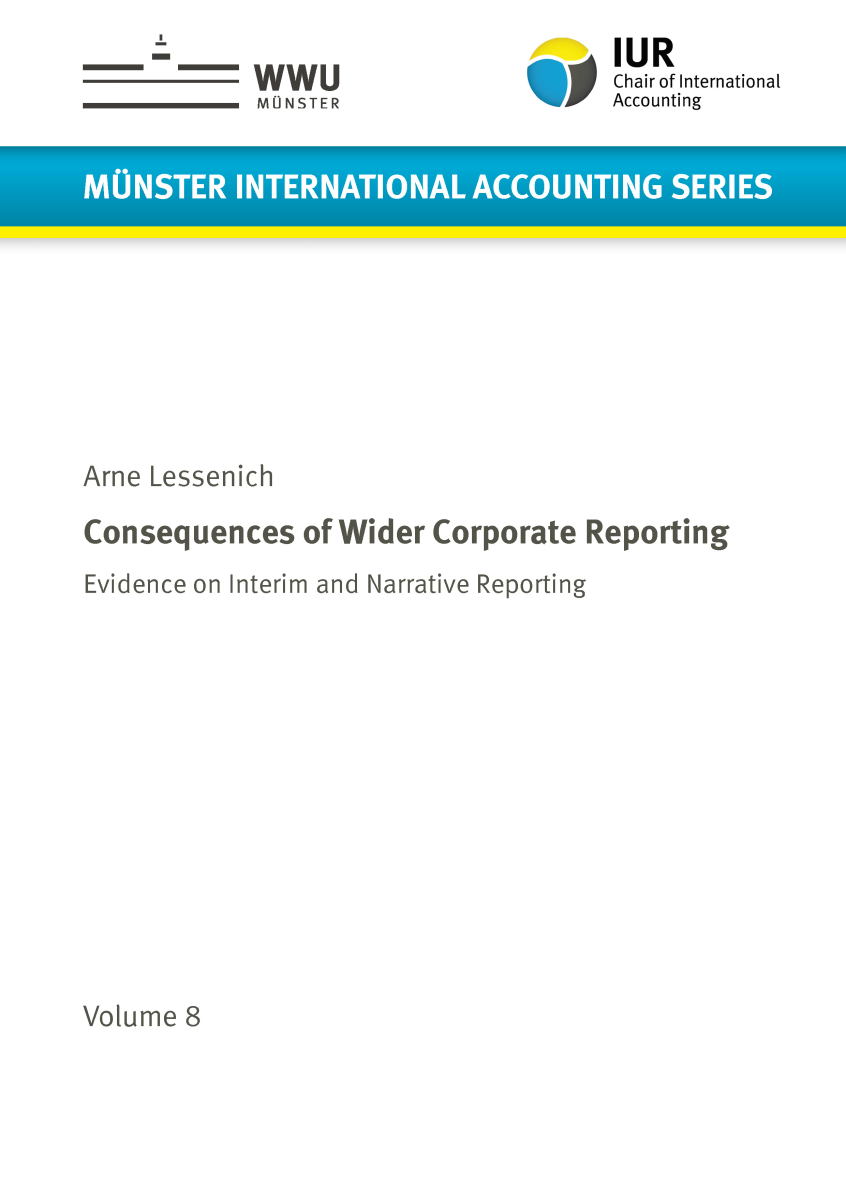Volume 8
Arne Lessenich – Consequences of Wider Corporate Reporting – Evidence on Interim and Narrative Reporting
 Although annual financial statements continue to form a core element of financial reporting, they are silent about many issues that are important for investment decisions. For example, they do not contain information about a firm’s business model or critical developments and resources that may affect profits. Such financial statements are backward-oriented and rarely contain forward-looking information that facilitates the assessment of future performance. Additionally, annual financial statements may not provide timely information because they may deal with transactions that have occurred more than a year before their publication.
Although annual financial statements continue to form a core element of financial reporting, they are silent about many issues that are important for investment decisions. For example, they do not contain information about a firm’s business model or critical developments and resources that may affect profits. Such financial statements are backward-oriented and rarely contain forward-looking information that facilitates the assessment of future performance. Additionally, annual financial statements may not provide timely information because they may deal with transactions that have occurred more than a year before their publication.
Because of the deficiencies of annual financial statements, additional disclosure venues have emerged to fulfill investors’ information needs. Two major reporting venues in this context are interim and narrative reporting. Interim reporting can overcome the weaknesses of annual financial reporting by increasing information timeliness and the amount of public information. Currently, most economies worldwide obligate at least publicly traded firms to publish interim reports. However, regulations regarding the design and frequency of interim reporting still vary considerably.
Similar to interim reports, narrative reports are an established disclosure venue, for example, in the form of management reports. These reports broaden the perspective of financial statements by providing additional information, such as a description of the business model, an analysis of economic developments, a display of research and development activities, and outlooks. Regulators around the world have reached a consensus that at least publicly traded firms must disclose a management report. Recently, sustainability reports have emerged as another form of narrative reporting. Such reports extend the scope of traditional financial reporting by providing information on environmental, social, or governance (ESG) issues. Although such reports are still voluntary in many countries, some jurisdictions have begun to mandate sustainability reports or are currently evaluating such a regulation. While the requirement to publish some form of a narrative report is widely consistent across jurisdictions, heterogeneity exists regarding the audit of narrative disclosures. While audits of narrative reports are still relatively new, they might be of great relevance given the criticism that narrative reports are often of low quality and contain boilerplate information.
Given the relevance and controversy of interim and narrative reporting, the three studies of this thesis explore the consequences of interim and narrative reporting. The first study “Consequences of Interim Reporting: A Literature Review and Future Research Directions” reviews the research examining the consequences of interim reporting. This review identifies three primary interim reporting characteristics, that is, reporting (1) frequency, (2) contents, and (3) assurance, and structures the analysis in line with these characteristics. Within these three characteristics, the review considers benefits and costs and examines both firm-specific consequences and externalities of interim reporting. The review reconciles the findings of previous studies and identifies trends and avenues for future research.
In light of the current debate on how to make businesses more sustainable, the second study “The Effect of Mandatory Quarterly Reporting on Sustainability Performance” examines the effect of reporting frequency on firms’ sustainability performance. The study exploits the introduction of IMS in the EU with the Transparency Directive. This directive increased the mandatory reporting frequency from half-yearly to quarterly in all EU member states, although some member states already required quarterly reporting via national law or stock exchange regulation. The setting allows the establishment of a plausible causal link between firms’ reporting frequency and their sustainability performance.
The third study “The Consequences of Mandatory Audits for Narrative Disclosures” focuses on the consequences of mandatory audits for narrative disclosures and considers (1) the consequences for the audited object itself, that is, the narratives, (2) the consequences for overall audit quality, and (3) the consequences for the users of financial reports. Furthermore, it explores the direct costs of mandatory audits of narrative disclosures. The study exploits the introduction of mandatory audits of management reports in the EU with Directive 2013/34/EU and uses a difference-in-differences research design to make causal claims. To complement the quantitative results, the study provides novel field evidence through semi-structured interviews.
Together, the three studies of this thesis provide novel evidence on current topics in the context of wider corporate reporting and highlight the consequences of different reporting decisions by firms and the different mandates of regulators. Thus, the insights generated by this thesis yield important implications for investors and may help regulators in their evaluation of how interim and narrative reporting should be regulated.


